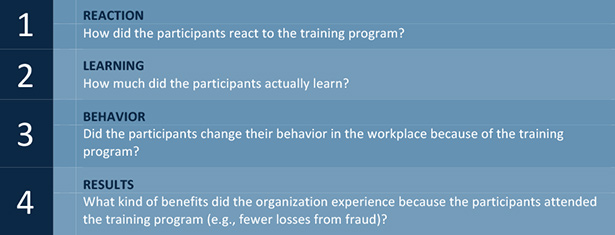Seven Steps for Designing an Anti Fraud Training Program
Apr 14, 2015
Apr 14, 2015
Employees are a valuable source of information for discovering potential fraud. According to the 2014 Report to the Nations on Occupational Fraud and Abuse, which analyzed nearly 1,500 cases of occupational fraud worldwide, more than 40 percent of the cases studied were discovered through tips, and employees were the source of almost half of all tips.It is therefore important to provide anti-fraud training to all employees, especially those in high-risk areas.Effective anti-fraud training offers several benefits. Well-trained employees can identify suspicious activity, and, through the training, management can communicate its commitment to high ethical standards and fraud prevention. Effective anti-fraud training can also improve employee morale and lead to increased compliance with legal and regulatory obligations and standards.But how does one create an anti-fraud training program? It can be daunting to start from scratch, so this article explains a seven-step approach for designing an effective anti-fraud training program. This approach, although not exhaustive, should serve as an effective guide to creating employee-training programs that actually work.
Define your organization’s training needs by identifying weak areas where training is required most. Generally, the training needs are those areas in which employees lack the skills or knowledge to combat fraud.
Defining the organization’s training needs will provide some benchmarks against which to evaluate the effectiveness of the resulting training program.
There are many ways to determine an organization’s training needs, including:
Learning objectives are brief statements that describe the knowledge and skills that learners will be expected to have by the end of the training program. They should relate directly to the training needs determined by the process outlined in the first step.
Learning objectives are necessary because management should not provide training unless it is clear why it is doing it. That is, fraud awareness training should directly support an organizational learning objective.
Also, learning objectives should be specific and measureable. Simply stating, “Learners need to know the red flags of fraud” does not provide enough detail. How can you know whether the learners know the red flags? Instead, a better learning objective would be, “Learners will be able to reason through hypothetical scenarios using a four-step approach to identify red flags of procurement fraud.” This objective establishes what the learners need to learn, and it provides a specific metric that can be tested during the training.
Decide who should receive the training. This step is crucial, especially for smaller organizations, because employee training is expensive and selecting the right trainees is important to the program’s success. It would be unwise to implement an organization-wide training effort that does not concentrate resources where they are needed most.
Some training programs, such as those covering organizational policies, should be provided to all employees, but other forms of training, such as how to recognize counterfeit goods from authentic trademarked goods, might only benefit employees whose positions are affected by such knowledge.
Moreover, when designing a training program, consider the employees’ ability to learn the material and use it and other resources as efficiently as possible.
There are many ways to conduct anti-fraud training, but picking the best method or methods to deliver training is necessary to ensure success. In short, training should be presented in a manner appropriate for the target audience. Consider the characteristics of the audience to determine the method of training that will be most beneficial to them.
Common methods of training include:
Often, live training is preferable because it allows employees the opportunity to participate actively, interact with each other, discuss the risks facing the organization, and seek and provide feedback regarding the training program as a whole.
Typically, training content is developed in-house by staff with experience in employee training or purchased from an outside vendor.
While developing the content, keep the following points in mind:
This step includes informing the employees about the training and giving them enough notice so they can work it into their schedules. It might also include things like informing the employees’ supervisors, reserving rooms, developing a training schedule, obtaining any necessary supplies, and so on.
A learning management system (LMS) can be beneficial during this step. A LMS is a software application used to administer, document, track, report, assess, and deliver electronic courses or training programs.
Evaluate the effectiveness and impact of the training immediately after completion. The standard way to evaluate the effectiveness of a training program is to use Kirkpatrick’s Four-Level Training Evaluation Model. This model focuses evaluation efforts on four different levels, which are summarized in the table below.

Employees are one of the best weapons in the fight against fraud, and an effective fraud-training program is one of the best ways to prepare employees in this fight. By equipping employees with the tools and knowledge to recognize and report fraud, management can ensure a stronger first line of defense against fraud.